My Cart
Your Shopping Cart is currently empty. Use Quick Order or Search to quickly add items to your order!
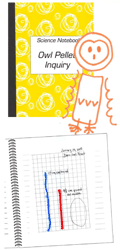
This fun, hands-on introductory dissection is a great springboard for teaching the techniques of using a science notebook while having students engage in the scientific practices of asking questions, planning and carrying out investigations, analyzing and interpreting data, constructing explanations, and obtaining, evaluating, and communicating information..
Do you want to teach your students to think like scientists? Do you want to incorporate more inquiry and science notebooking in your classes? Then exploring owl pellets is the perfect project.
Science notebooks are a record of scientific data, observations, and other information—and scientists value them. In the elementary classroom, science notebooks help students make sense of their observations and organize information. Notebooks are also convenient places for students to ask/record questions and make/record predictions, whether they do so using words or pictures or both. Spiral notebooks, marble composition notebooks, or folders with fasteners work very well. Just remember that it’s important to secure the pages together in some way.
Let’s talk a minute about notebook entries. For young students, entries may include a drawing, a word, a simple chart, and perhaps a few sentences. As students get older, expect more detailed drawings, longer descriptions, and more elaborate data tables, graphs, or charts.
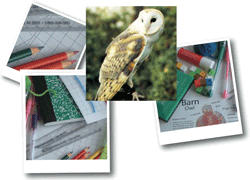
Review the materials list. Colored pencils help students make accurate drawings. Younger children might prefer crayons. Yarn is a wonderful graphing tool and works well with graph paper. Notice that this is a starter list. You may also want to consider a hand lens, centimeter rulers, and other tools for your young scientists.
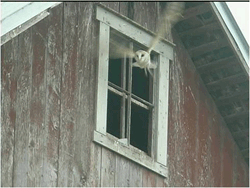
Guide a class discussion about owls. Discuss physical characteristics, habitat, and food sources. Have students ask questions for which they want answers. Guide them, if necessary, to questions such as:
Now, pass out the wrapped owl pellets and ask each student to hold the pellet without unwrapping it. Ask your students to consider what they know about owls. Then ask, “What do you expect to find inside this foil-wrapped package?” Have students record their responses in their science notebooks. Remind them to date their entries. You may want to use open-ended questions to encourage students to make rather specific predictions.
Here are some questions to help guide student responses. The idea is to get them thinking so that they can make predictions.
Now instruct students to unwrap their pellets, but do not break the pellets apart. Ask them to use supplied materials on their tables to discover all they can about the intact pellets. Have students record their findings in their science notebooks. Encourage informal sharing of ideas at each table. Students can gather data from the unwrapped pellets by doing any of the following activities.
Your students may find other ways to gather data. Encourage them to think like scientists and find new ways to explore the unknown.
Now let your students explore the interior of the pellet. Encourage them to find out all they can. Note: At this point, students are conducting their own investigation and are not using bone charts. Allow students the luxury of grouping/classifying bones using student-generated rules. Looking at bones without the bone chart helps them carefully consider form and function instead of simply matching bones to the diagram.
Use open-ended questions to encourage thoughtful grouping of the bones.
Have students record observations in their science notebooks. After allowing ample time for student-generated investigation and grouping of bones, ask students to make predictions.
What animal might these bones belong to? Are there bones of more than one animal? What evidence supports your predictions? Have students record their ideas.
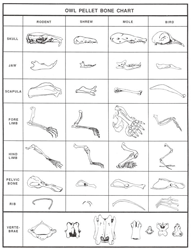
At this point, give each student a bone chart. Have your young scientists actively compare their groupings to the chart. Encourage them to work like scientists to identify the contents of the pellets.
After comparing their groupings to the chart, students can use the chart to make any necessary regrouping of individual bones. They then record these observations in their science notebooks, or on charts or blackline record sheets provided for that purpose. Simply staple, glue, or tape charts or record sheets into the science notebooks.
Encourage students to look closely at the relationship of form and function (e.g., ball/socket joint, size and thickness of hind limb bones), and how this might relate to the animal’s movement. Allow ample time for them to complete the investigation and record the findings in their science notebooks.
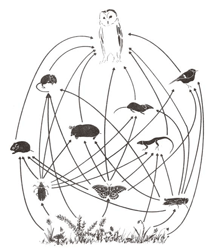 There are many opportunities for extending the lesson. Time permitting, students may glue the bones on heavy paper, or perhaps in a petri dish or CD case, as they reconstruct the animal skeleton as much as possible. Younger students may extend the lesson by gluing together an imaginary animal and describing how that animal moves, what the animal eats, etc. Using what they now know about form and function, the children can choose bones that enable the imaginary animal to move as described.
There are many opportunities for extending the lesson. Time permitting, students may glue the bones on heavy paper, or perhaps in a petri dish or CD case, as they reconstruct the animal skeleton as much as possible. Younger students may extend the lesson by gluing together an imaginary animal and describing how that animal moves, what the animal eats, etc. Using what they now know about form and function, the children can choose bones that enable the imaginary animal to move as described.
Consider other lessons you can teach using the gathered information and/or science notebooks. For example, students could use observations and findings recorded in their notebooks, as well as class graphs and data, and begin building an understanding of food webs.
Get creative! There is no better tool for young scientists than a great investigation paired with a place to record what they see, think, and question.
Learn more about our extensive selection of owl pellets and resources at www.carolina.com/preserved, where you will also find secure online shopping, product information, classroom resources, activities, and additional teaching tips.
*Next Generation Science Standards® (NGSS) is a registered trademark of Achieve. Neither Achieve nor the lead states and partners that developed the Next Generation Science Standards were involved in the production of, and do not endorse, these products.